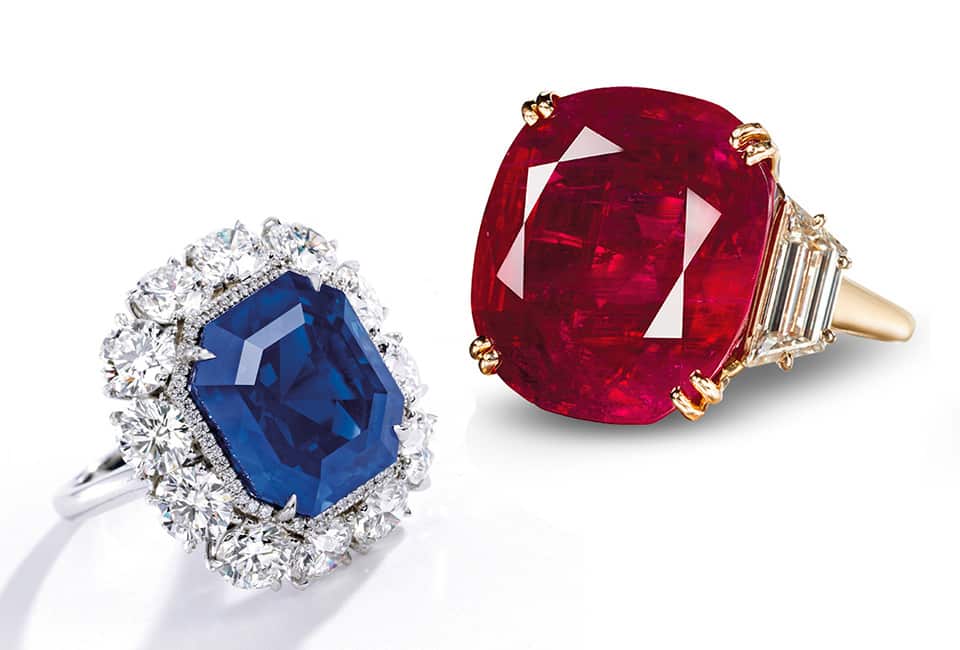Ruby and Sapphires are varieties of gems in the corundum species of minerals. A corundum species mineral has the basic chemical composition of Aluminum Oxide (Al203) and it belongs to trigonal crystal system. Pure corundum has no colour and is referred to as white sapphire which is transparent and clear as water. When about 1-3% of chromium (Cr) is present as an impurity replacing alumi-num (Al) atoms in the crystal lattice it acquires a red colour and is then called ruby. With lesser amounts of Cr, it becomes light red and the stone is then referred to as a pink sapphire. When corundum has about 1% of Titanium (Ti) and Iron (Fe) replacing Al, it becomes blue in colour and is thus known as a blue sapphire. The presence of small quantities of Fe, Cr, Ti and vanadium (V), alone or togeth-er, also produce yellow, green, brown, violet and reddish orange coloured corundum and these varieties are all identified as sapphires with prefix of the applicable colour. Reddish orange corundum gems are referred to as Padmar-aga , a Sanskrit word meaning Padma – lotus flower and raga – colour. Because Padmaraga is very beautiful and rare, it has become very popular and the name has been westernized as Padparadscha (http:/ /en.wikipe-dia.org/wiki/Sapphire) because it is very popular and expensive like rubies.
Common properties of corundum species of gemstones are: refractive indices: 1.76-1.77, Birefringence: 0.009, hardness: 9, and specific gravity: 3.99. Ruby and sapphires have their own characteristic absorption spectra. Brown and green sapphires are not very common or sought after.
Unlike ruby which has a unique red colour also referred to as “Pigeon blood red”, all the sapphires can be light, medium or optimum in their colour. Ruby and blue sapphire can also exceed optimum colour and reach black. As the colour goes past optimum, the beauty, value and demand drops. The best colour of blue sapphire is consid-ered to be that of the ‘Corn flower’ or locally that of the Katarolu flower or the colour of the neck of a Peacock. The optimum colour also has a subjective element and in blue sapphire slightly varies for different nationalities. Italians seem to prefer slightly darker blue and Japanese and French prefer slightly lighter colour of blue than corn flower blue.
There is some controversy on the colour of Padmaraga. Even after decades of debate, this is still being discussed. Most eminent gemologists in the world state that the real colour of Padmaraga is a mixture of the colour of lotus flower and that of a tropical sun-set. For a long time it was believed that the Padmaraga is found only in Sri Lanka and we have the right to the name Padmaraga. However during the recent past similar coloured sapphires have been found in Vietnam, Tanzania, Madagascar and Mozambique and named Padparadascha. It is nevertheless recognized that the Padm’araga gem variety was originally discovered and mined in Sri Lanka.
About 80% of gem exports by value in Sri Lanka come from sapphires, of which 60% are blue sapphires and 1.5% is rubies. The importance of Blue Sapphire is such that in 2003,it was named as the National Gemstone of Sri Lanka and several stamps with Blue Sapphires was issued.
Major ruby producing countries in the world are Myanmar, Vietnam, Madagascar, Cambodia, Kenya, Tanzania and Mozambique. Sri Lanka is the largest producer of blue sapphires and with Myanmar, Madagascar, Tanzania to follow. Ruby and sapphires are produced in more countries. It has become important to state the country of origin in individual gem identification reports. Blue sapphire from

